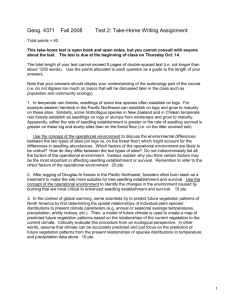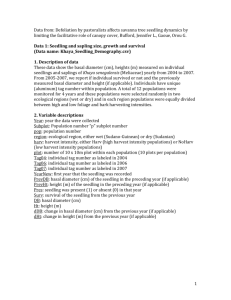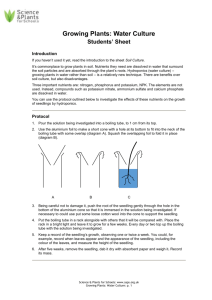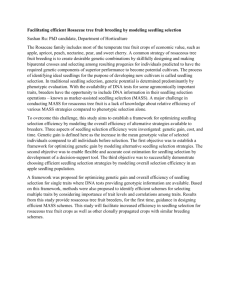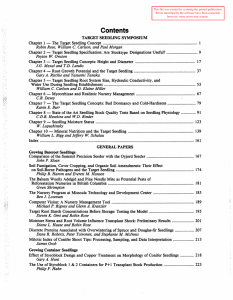FOREST NURSERY Demonstrate knowledge of the steps bare root seedling
advertisement
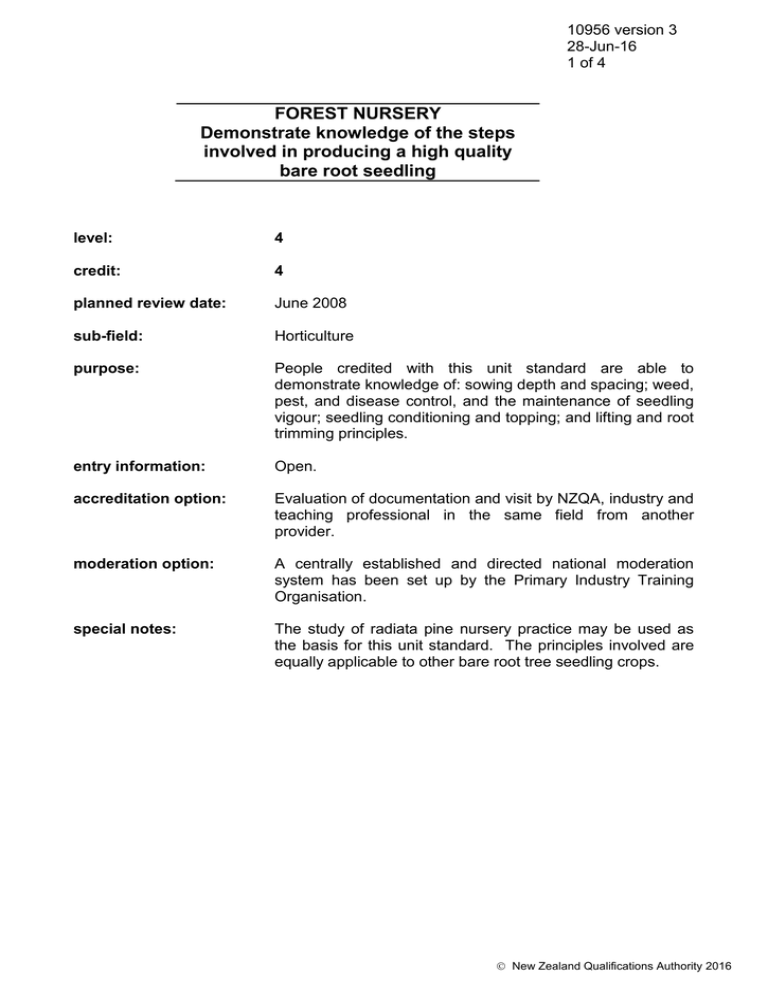
10956 version 3 28-Jun-16 1 of 4 FOREST NURSERY Demonstrate knowledge of the steps involved in producing a high quality bare root seedling level: 4 credit: 4 planned review date: June 2008 sub-field: Horticulture purpose: People credited with this unit standard are able to demonstrate knowledge of: sowing depth and spacing; weed, pest, and disease control, and the maintenance of seedling vigour; seedling conditioning and topping; and lifting and root trimming principles. entry information: Open. accreditation option: Evaluation of documentation and visit by NZQA, industry and teaching professional in the same field from another provider. moderation option: A centrally established and directed national moderation system has been set up by the Primary Industry Training Organisation. special notes: The study of radiata pine nursery practice may be used as the basis for this unit standard. The principles involved are equally applicable to other bare root tree seedling crops. New Zealand Qualifications Authority 2016 10956 version 3 28-Jun-16 2 of 4 FOREST NURSERY Demonstrate knowledge of the steps involved in producing a high quality bare root seedling Elements and Performance Criteria element 1 Demonstrate knowledge of sowing depth and spacing. performance criteria 1.1 Optimum depth of sowing is stated, and the effects of sowing depth on seedling emergence are identified. Range: 1.2 seed thickness, drying out, seed covering, herbicide damage. Optimum spacings and the effect of spacing on seedling development are identified. Range: sturdiness, basal branch development, root collar diameter, light, geographical location of nursery. element 2 Demonstrate knowledge of weed, pest, and disease control and of maintenance of seedling vigour. performance criteria 2.1 Optimum weed control outcomes are stated, and the consequences of inadequate weed control on seedling quality and on nursery management are identified. Range: 2.2 weed competition, root damage, hand weeding, weed seeds, residual herbicides, knock down herbicides, selective and non selective herbicides, spot spraying, time of application, lifting costs. Major pests and diseases are identified with reference to their effect on seedling quality. Range: malformation, culling. New Zealand Qualifications Authority 2016 10956 version 3 28-Jun-16 3 of 4 FOREST NURSERY Demonstrate knowledge of the steps involved in producing a high quality bare root seedling 2.3 Practices used to maintain seedling vigour are outlined in relation to the nutritional requirements of seedlings. Range: inter-row fertiliser applications, foliar applications, deficiency systems, rates, timing. element 3 Demonstrate knowledge of seedling conditioning and topping. performance criteria 3.1 Conditioning treatments are described in relation to their effect on seedling development. Range: 3.2 height growth, diameter growth, sturdiness, root development, mycorrhizal development, undercutting, lateral root pruning, wrenching. The need for topping and topping practices are outlined with reference to their effect on seedling shoot development. Range: fascicle buds, small shoots, hardening off. element 4 Demonstrate knowledge of lifting and root trimming principles. performance criteria 4.1 Lifting techniques are detailed, and their effect on seedling quality is identified. Range: 4.2 pre-lift loosening by machine, pre-lift loosening by hand, foliage damage, root stripping, teasing, bunch lifting, single tree lifting, tertiary roots, mycorrhizae, exposure, root regeneration, height growth. Root trimming is explained with reference to its effect on root placement at time of planting. New Zealand Qualifications Authority 2016 10956 version 3 28-Jun-16 4 of 4 FOREST NURSERY Demonstrate knowledge of the steps involved in producing a high quality bare root seedling Comments on this unit standard Please contact Primary Industry Training Organisation http://www.primaryito.ac.nz if you wish to suggest changes to the content of this unit standard. Please Note Providers must be accredited by the Qualifications Authority or a delegated interinstitutional body before they can register credits from assessment against unit standards or deliver courses of study leading to that assessment. Industry Training Organisations must be accredited by the Qualifications Authority before they can register credits from assessment against unit standards. Accredited providers and Industry Training Organisations assessing against unit standards must engage with the moderation system that applies to those standards. Accreditation requirements and an outline of the moderation system that applies to this standard are outlined in the Accreditation and Moderation Action Plan (AMAP). The AMAP also includes useful information about special requirements for providers wishing to develop education and training programmes, such as minimum qualifications for tutors and assessors, and special resource requirements. This unit standard is covered by AMAP 0032 http://www.nzqa.govt.nz/site/framework/search.html. which can be accessed at New Zealand Qualifications Authority 2016
